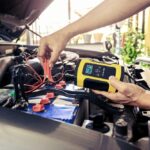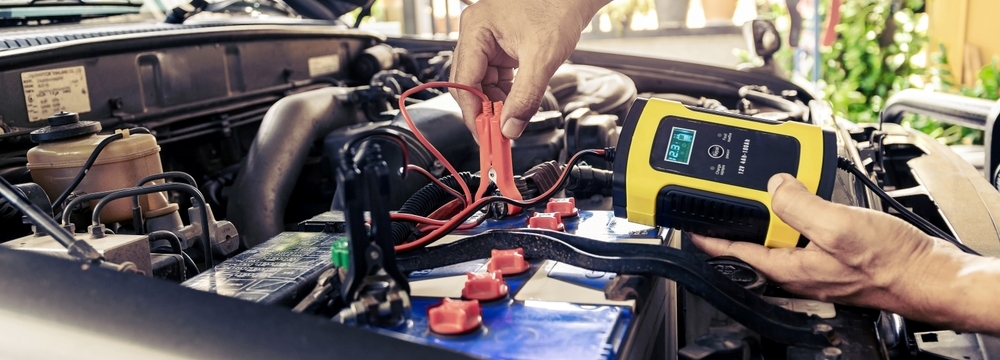 Modern vehicles come equipped with many more electronic gizmos (GPS, entertainment, and sensors for everything) than our parents’ cars. I remember as a kid, the ‘air conditioning’ was the hand crank to lower the back seat window next to me. We used maps to get around, and watching movies in the car wasn’t even a thing. In today’s world, new cars rely heavily on electronics to operate every system. Extending the life of your car battery is more important than ever. The car battery maintenance tips below will cover basic battery service tasks (like removing corrosion) and how to spot signs of a dying battery.
Modern vehicles come equipped with many more electronic gizmos (GPS, entertainment, and sensors for everything) than our parents’ cars. I remember as a kid, the ‘air conditioning’ was the hand crank to lower the back seat window next to me. We used maps to get around, and watching movies in the car wasn’t even a thing. In today’s world, new cars rely heavily on electronics to operate every system. Extending the life of your car battery is more important than ever. The car battery maintenance tips below will cover basic battery service tasks (like removing corrosion) and how to spot signs of a dying battery.
What Is Car Battery Maintenance?
Battery maintenance is just regularly performing tasks to ensure your vehicle starts reliably and performs effectively. Neglecting your car battery can lead to excessive corrosion, unexpected breakdowns, and expensive repairs. The maintenance tips below will help you perform a few basic battery service tasks.
Remove Corrosion
Corrosion is the white (or sometimes blue or green) powdery substance found around your car battery. Too much of that residue on battery terminals can hinder the flow of electricity and reduce the efficiency of your battery. To remove corrosion buildup, apply a solution of baking soda and water to the terminals, then gently scrub with a soft-bristled brush. Continue this process until the corrosion is no longer visible. After cleaning and rinsing thoroughly, apply a layer of petroleum jelly or protective spray (available at your local retail auto parts store) to the terminals to help deter future corrosion development.
Check Battery Cables
The red cap, post, or connector denotes the positive side of the battery. When cleaning, always remove the negative (black cap) side first. Disconnect the wires to the negative terminal by turning the bolt counterclockwise and pry the connection off the terminal. Then, remove the positive side the same way. Make sure that you do not touch either of the battery cables to any metal car components.
To put them back on, reconnect the (red) positive battery cable to the positive terminal first and then connect the (black) negative battery cable to its post. Make sure you tighten the bolts so the cables are secure but not so tight that you damage the post.
Clean Battery Tray
The battery tray is the part that holds your vehicle’s battery. It requires periodic cleaning because debris can compromise the battery’s performance and longevity. Remove dirt, rust, and corrosion with a soft brush and a cleaning solution of water & baking soda. Dry the tray thoroughly before replacing the battery.
Tighten Battery Strap
Once your battery is free of corrosion and returned to its designated space, be sure to tighten the battery strap or bracket securely. A loose battery will shift around as you drive your car. Not only can this be dangerous, but it can damage other components and reduce your battery’s lifespan. Tighten all connections to prevent excess battery movement.
Check Battery-Fluid Levels
Many car batteries are maintenance-free, but if yours isn’t, you need to check the electrolyte levels regularly. If the fluid level is low, refill it with distilled water. Be cautious not to add too much water, as caustic spills can cause damage to your car battery and its surrounding components.
More Car Battery Maintenance Tips
These next maintenance tips go beyond cleaning and inspecting your car battery. Below, I’ll cover driving hacks, helpful accessories, and suggestions to help prolong your battery’s lifespan.
Trickle Charger
A trickle charger is a low-amperage tool that supplies a consistent charge to your car battery over a prolonged period. It is useful for vehicles in long-term storage.
Insulation Blanket
Cold weather is hard on your battery’s performance. An insulation blanket helps prevent the battery from getting too cold and losing charge. These blankets vary in design style but are easy to install and help maintain the battery’s internal temperature.
Bundle Short Trips
Frequently driving short distances can drain your battery faster than driving longer distances because the alternator doesn’t have enough time to recharge your battery fully. Try to bundle several short trips into a continuous longer drive to reduce the number of times the battery needs to start your vehicle.
Limit Electronics Usage
Using electronics like the A/C, entertainment system (radio, movies, GPS), cabin lights, or phone charging plugs can drain your car battery quickly if:
- Your car is idling and parked
- The engine is not running
To avoid putting an unnecessary load on the car battery, always turn off unnecessary electronics before turning off the engine.
Regulate Temperatures
Extreme temperatures (both hot & cold) can negatively affect your car battery’s performance and lifespan. During cold months, use an insulation blanket to protect the battery from freezing temperatures. During hot months, park your vehicle in the shade or garage to help keep the battery cool.
Routine Battery Service
You can perform routine battery service or bring your car to your trusted auto service center. For those who love DIY, wipe down the outer battery case, remove all corrosion, and invest in a battery tester to monitor your battery’s health. Whether you perform the service yourself or an auto technician does, regular cleaning, inspections, and testing help prevent unexpected battery issues.
Signs Your Car Battery Is Dying
Identifying the signs of a dying battery can help prevent you from being stranded with a car that won’t start. Remember, if your vehicle’s battery is malfunctioning or showing any of the signs below, replace it immediately. Let’s review some common traits of a dying car battery:
- Age: Every battery has an estimated lifespan of 3 to 10 years. Factors like climate, driving habits, and vehicle type will impact the longevity of your car battery.
- Bad Smell: A sulfur or rotten egg smell indicates your battery may be leaking or has charging issues.
- Cracked Battery Case: If the outer shell of the battery is swollen, cracked, or otherwise distorted, replace it immediately. Overcharging and extreme temperatures can damage your car battery. It is unsafe to operate your vehicle with a damaged battery.
- Dashboard Warning Light: Most cars have a ‘Battery’ icon warning light on their dashboard. When it illuminates, schedule a battery inspection as soon as possible to determine if the battery or charging system requires service or replacement.
- Electronic Issues: Problems like dim headlights or malfunctioning electronics can mean the battery lacks sufficient charge to operate correctly.
- Low Battery Fluid: Some batteries are refillable (with distilled water), but low fluid may indicate charging issues or a leaking battery requiring an immediate replacement.
- Sluggish Engine Crank: If your car’s engine cranks more slowly when starting or clicks without starting, your battery is likely dying.
Car Battery Service in Kirkland, WA
Fisher’s Auto Service, Inc. in Kirkland, WA, offers quick and easy car battery service appointments. Our experienced technicians can identify minor issues before they become major problems. From check-in to check-out, our experienced auto care advisors and technicians will promptly and efficiently maintain and repair your vehicle. We provide inspections, maintenance, and repairs for all Asian, European, and Domestic SUV, truck, and car models.
Schedule A Car Battery Service
Give us a call at (425) 823-4441, or visit us online to schedule your car battery service today!

